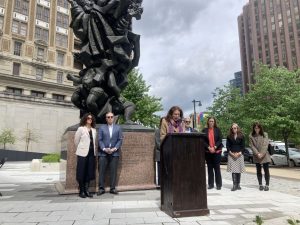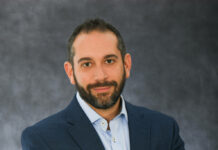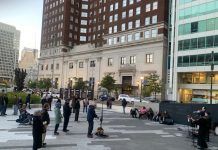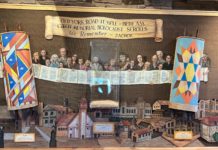
Mural Arts Philadelphia founder and Executive Director Jane Golden considers herself a “wall hunter,” roaming the streets of Philadelphia for blank concrete canvases.
For years, she’s visited the wall framing the Horwitz-Wasserman Holocaust Memorial Plaza on the Benjamin Franklin Parkway, reflecting on the site and hoping to one day transform the 2,000-square-foot panel behind it into a piece of public art.
“I would often pass by here, I would sit down, I would reflect on the space and all that it means: the context of 6 million Jews lost, the weight of their absence on generations of survivors and what the Holocaust means to us today as a multiracial, multicultural Philadelphia and Americans,” Golden, who is Jewish, said.
Soon, Golden’s hope will come to fruition.
The Philadelphia Holocaust Remembrance Foundation, in partnership with public arts nonprofit Mural Arts, announced on May 2 plans to bring a mural to the Horwitz-Wasserman Holocaust Memorial Plaza in 2024. The mural will be the first on the parkway and the first large-scale, publicly commissioned Holocaust mural in the United States, according to Philadelphia Holocaust Remembrance Foundation Executive Director Eszter Kutas.
“At a pivotal time when the community of Holocaust survivors can no longer lead the work of educating future generations … How do we reach young people who do not have a connection to this piece of history? How do we make sure that the lessons of the Holocaust stay in our public conscience?” Kutas said. “These are the questions that we grapple with as we program and advance this Holocaust memorial. So, in a way, adding a mural to the memorial to serve as a backdrop to this historical place seems like a natural evolution.”
Over the next 18 months, the organizations will facilitate a multistep artist selection process with community input and unveil the mural outside of the plaza next fall. The partnering organizations are looking for artists who have experience with large-scale projects such as murals, with personal, communal or cultural connections to the Holocaust.
The idea for the mural came from Philadelphia Holocaust Remembrance Foundation board Co-chair Jacob Reiter.
“Art can be therapeutic and instructive to artists and viewers, and public art is one of the most powerful tools society has to educate and inspire communities while beautifying public spaces,” he said.
Golden called the mural a challenging project that has to tackle a sensitive topic while also complementing the plaza’s other symbolic sites.
At the May 2 press conference, the Holocaust foundation and Mural Arts invited students from Friends Select School to decorate rocks with symbols of hope to adorn the base of the “Monument to Six Million Jewish Martyrs” sculpture by artist and Holocaust survivor Nathan Rapoport.
The plaza is home to a sapling from a cutting of a tree found in the Theresienstadt concentration camp, a set of original train tracks from the Treblinka extermination camp and six pillars with inscriptions of American ideals to frame the experience of visiting the plaza. The University of Southern California’s Shoah Foundation developed an “iWalk” app to accompany the plaza’s components, which were added to the site in a 2018 update.
A mural is a natural next step for the Holocaust foundation, as it will increase visibility and draw in new visitors. Murals as a form of public art have powerful roots in Philadelphia, Golden said, making the medium fitting for the space between the Parkway and Arch St.
Golden founded Mural Arts in 1998 before spending 10 years at the Philadelphia Anti-Graffiti Network, which was founded in 1984, when the city encouraged the creation of murals as an alternative to graffiti.
“In the early years, murals were seen as a sign that people cared and that things could change,” Golden said. “And they became beacons and focal points around which people felt like they could create other changes.”
Mural Arts previously worked with the Anti-Defamation League Philadelphia and the Jewish Federation of Greater Philadelphia on public art campaigns.
“It’s about beautification and lifting our spirits and challenging us to think differently,” she said. “It does all those things.”






